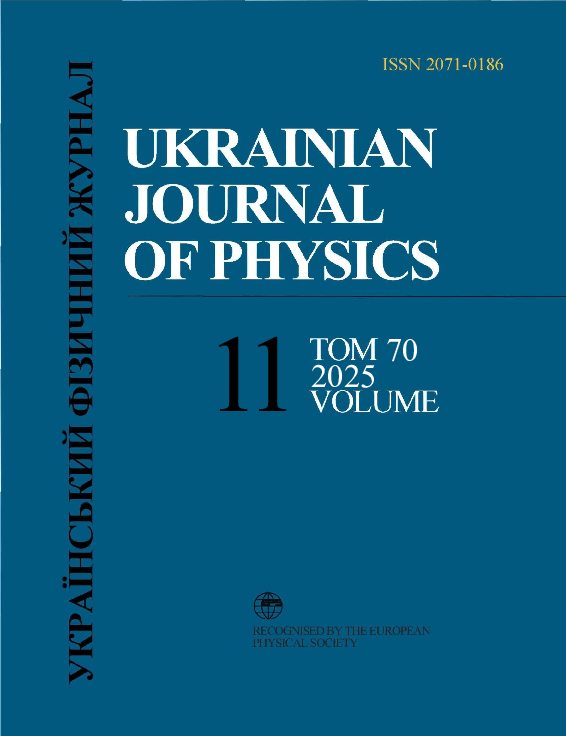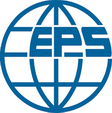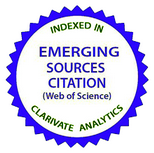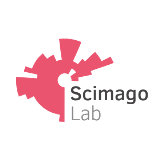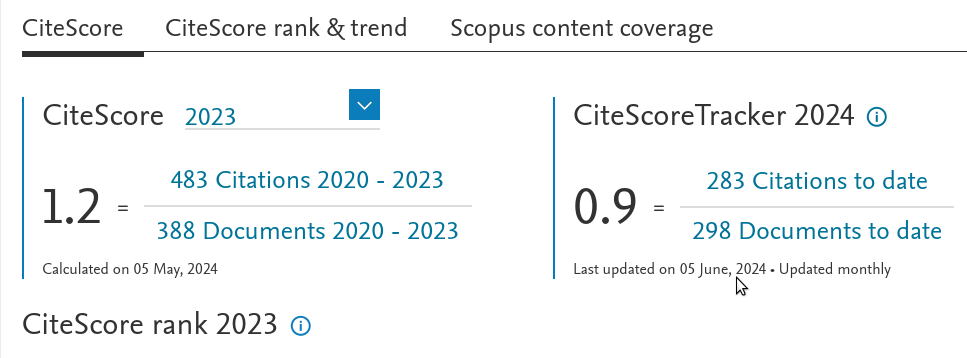Complexation of Ibuprofen with Bovine Serum Albumin: Spectroscopic Study and Molecular Simulation
DOI:
https://doi.org/10.15407/ujpe70.11.776Keywords:
bovine serum albumin, ibuprofen, fluorescence quenching, molecular dockingAbstract
The interaction of ibuprofen with bovine serum albumin (BSA) in the aqueous environment has been studied using both experimental and computer simulation methods. The fluorescence quenching spectra are obtained at a constant BSA concentration of 2μM, varying ibuprofen concentrations of 0–1.5 μM, and three fixed temperatures of 293, 303, and 313 K. The intensity dependences follow the Stern–Volmer equation and testify to the static quenching mechanism. Together with the temperature-induced growth of the binding constant, this result points to the predominantly hydrophobic nature of the interaction. The obtained binding constants equal lg KS = 4.3÷5.0 at the binding stoichiometry close to 1 : 1. The thermodynamic analysis of the complexation showed that ΔG < 0, ΔH > 0, and ΔS > 0, G, H, S which confirms the spontaneous and entropy-driven character of the binding process. Molecular docking simulation using AutoDock 4.2.6 made it possible to identify three main binding sites of ibuprofen with BSA. The most energetically favorable binding modes include van der Waals, hydrogen bonding, hydrophobic, and electrostatic interactions; nevertheless, contacts with hydrophobic residues of BSA prevail. The calculated spatial arrangement of ibuprofen with respect to tryptophan residues corresponds to the experimentally observed fluorescence quenching.
References
1. F. Simonelli, G. Rossi, L. Monticelli. Role of ligand conformation on nanoparticle-protein interactions. J. Phys. Chem. B 123, 1764 (2019).
https://doi.org/10.1021/acs.jpcb.8b11204
2. A.L. Mart'ınez-L'opez, C. Pangua, C. Reboredo, R. Campi'on, J. Morales-Gracia, J.M. Irache. Protein-based nanoparticles for drug delivery purposes. Int. J. Pharm. 581, 119289 (2020).
https://doi.org/10.1016/j.ijpharm.2020.119289
3. T. Pho, J.A. Champion. Surface engineering of protein nanoparticles modulates transport, adsorption, and uptake in mucus. ACS Appl. Mater. Interfaces 14, 51697 (2022).
https://doi.org/10.1021/acsami.2c14670
4. A. Bujacz. Structures of bovine, equine and leporine serum albumin. Acta Crystallogr. D Biol. Crystallogr. 68, 1278 (2012).
https://doi.org/10.1107/S0907444912027047
5. A. Michnik, K. Michalik, A. Kluczewska, Z. Drzazga. Comparative DSC study of human and bovine serum albumin. J. Therm. Anal. Calorim. 84, 113 (2006).
https://doi.org/10.1007/s10973-005-7170-1
6. X. Xu, J. Hu, H. Xue, Y. Hu, Y. Liu, G. Lin, L. Liu, R. Xu. Applications of human and bovine serum albumins in biomedical engineering: A review. Int. J. Biol. Macromol. 253, 126914 (2023).
https://doi.org/10.1016/j.ijbiomac.2023.126914
7. E. Karami, M. Behdani, F. Kazemi-Lomedasht. Albumin nanoparticles as nanocarriers for drug delivery: Focusing on antibody and nanobody delivery and albumin-based drugs. J. Drug Deliv. Sci. Technol. 55, 101471 (2020).
https://doi.org/10.1016/j.jddst.2019.101471
8. O. Holovko, O. Dmytrenko, M. Kulish, A. Lesiuk, O. Pavlenko, A. Naumenko, M. Kaniuk, I. Doroshenko. Mechanisms of heteroassociation in aqueous solutions of BSA with curcumin. J. Mol. Liq. 415, 126364 (2024).
https://doi.org/10.1016/j.molliq.2024.126364
9. O.O. Holovko, O.P. Dmytrenko, A.I. Lesiuk, M.P. Kulish et al. Mechanisms of the interaction of bovine serum albumin with quercetin. Mol. Cryst. Liq. Cryst. 768, 29 (2024).
https://doi.org/10.1080/15421406.2023.2238505
10. O. Dmytrenko, M. Kulish, O. Pavlenko, A. Lesiuk, A. Momot, T. Busko, M. Kaniuk, T. Nikolaienko, L. Bulavin. Mechanisms of heteroassociation of ceftriaxone and doxorubicin drugs with bovine serum albumin. In: Soft Matter Systems for Biomedical Applications (Springer, 2022).
https://doi.org/10.1007/978-3-030-80924-9_8
11. N.A. Goncharenko, O.P. Dmytrenko, O.L. Pavlenko, M.P. Kulish, I.P. Pundyk, A.I. Lesyuk, T.O. Busko et al. Complexation peculiarities in "Doxorubicin-Bovine Serum Albumin-Gold Nanoparticles" heterosystem. Ukr. Fiz. Zh. 65, 464 (2020).
https://doi.org/10.15407/ujpe65.6.468
12. R. Jin, D. Song, H. Xiong, L. Ai, P. Ma, Y. Sun. Magnetic core/shell Fe3O4/Au nanoparticles for studies of quinolones binding to protein by fluorescence spectroscopy. Luminescence 31, 499 (2016).
https://doi.org/10.1002/bio.2988
13. S. Kaumbekova, N. Sakaguchi, D. Shah, M. Umezawa. Effect of gold nanoparticles on the conformation of bovine serum albumin: insights from CD spectroscopic analysis and molecular dynamics simulations. ACS Omega 9, 49283 (2024).
https://doi.org/10.1021/acsomega.4c06409
14. A. Spada, J. Emami, J.A. Tuszynski, A. Lavasanifar. The uniqueness of albumin as a carrier in nanodrug delivery. Mol. Pharm. 18, 1862 (2021).
https://doi.org/10.1021/acs.molpharmaceut.1c00046
15. N. Qu, K. Song, Y. Ji, M. Liu, L. Chen, R.J. Lee, L. Teng. Albumin nanoparticle-based drug delivery systems. Int. J. Nanomed. 2024, 6945 (2024).
https://doi.org/10.2147/IJN.S467876
16. M. Bukackova, R.J.B.C. Marsalek. Interaction of BSA with ZnO, TiO2, and CeO2 nanoparticles. Biophys. Chem. 267, 106475 (2020).
https://doi.org/10.1016/j.bpc.2020.106475
17. R. Thiramanas, Y. Wongngam, G. Supanakorn, D. Polpanich. BSA adsorption on titanium dioxide nanoparticle surfaces for controlling their cellular uptake in skin cells. ACS Appl. Bio Mater. 7, 1713 (2024).
https://doi.org/10.1021/acsabm.3c01138
18. M. Lokolkar, A. Udnoor, M.S. Ali, U. Katrahalli, M.N. Kalasad, H.A. Al-Lohedan, M.D. Hadagali. Investigations on the complexation and binding mechanism of bovine serum albumin with Ag-doped TiO2 nanoparticles. Phys. Chem. Chem. Phys. 26, 26453 (2024).
https://doi.org/10.1039/D4CP02056A
19. O.O. Honcharova, O.P. Dmytrenko, A.I. Lesiuk, M.P. Kulish, O.L. Pavlenko, A.P. Naumenko, I.Yu. Doroshenko, N.M. Zholobak, M.I. Kaniuk. Binding parameters and conjugation mechanisms in the solutions of BSA with antioxidant CeO2 nanoparticles. Mol. Cryst. Liq. Cryst. 750, 144 (2023).
https://doi.org/10.1080/15421406.2022.2073044
20. P.P. Gorbyk, A.L. Petranovska, O.P. Dmytrenko, O.L. Pavlenko, I.P. Pundyk, T.O. Busko, T.M. PinchukRugal et al. Adsorption mechanisms of gemcitabine molecules on the surface of Fe3O4 nanoparticles with biocompatible coatings. In: Nanooptics and Photonics, Nanochemistry and Nanobiotechnology, and Their Applications: Selected Proceedings of the 7th International Conference Nanotechnology and Nanomaterials (NANO2019), 27-30 August 2019, Lviv, Ukraine (Springer, 2020), p. 195.
https://doi.org/10.1007/978-3-030-52268-1_15
21. J. Irvine, A. Afrose, N. Islam. Formulation and delivery strategies of ibuprofen: challenges and opportunities. Drug Dev. Ind. Pharm. 44, 173 (2018).
https://doi.org/10.1080/03639045.2017.1391838
22. X. Yuan, A.C. Capomacchia. Influence of physicochemical properties on the in vitro skin permeation of the enantiomers, racemate, and eutectics of ibuprofen for enhanced transdermal drug delivery. J. Pharm. Sci. 102, 1957 (2013).
https://doi.org/10.1002/jps.23548
23. I. Doroshenko, T. Rudenok, A. Lesiuk, A. Smal, O. Dmytrenko, L. Davtian, A. Drozdova. Peculiarities of ibuprofen interaction with polyethylene glycol polymer matrix. Low Temp. Phys. 51, 215 (2025).
https://doi.org/10.1063/10.0035405
24. Y. Ni, R. Zhu, S. Kokot. Competitive binding of small molecules with biopolymers: A fluorescence spectroscopy and chemometrics study of the interaction of aspirin and ibuprofen with BSA. Analyst 136, 4794 (2011).
https://doi.org/10.1039/c1an15550d
25. A. Ploch-Jankowska, D. Pentak. A comprehensive spectroscopic analysis of the ibuprofen binding with human serum albumin, part I. Pharmaceuticals 13, 205 (2020).
https://doi.org/10.3390/ph13090205
26. S. Evoli, D.L. Mobley, R. Guzzi, B. Rizzuti. Multiple binding modes of ibuprofen in human serum albumin identified by absolute binding free energy calculations. Phys. Chem. Chem. Phys. 18, 32358 (2016).
https://doi.org/10.1039/C6CP05680F
27. State Pharmacopoeia of Ukraine/State Enterprise "Scientific and Expert Pharmacopoeial Center". Supplement 1 (RIREG, 2004) [ISBN: 966-95824-3-1].
28. T. Peters. All About Albumin: Biochemistry, Genetics, and Medical Applications (Academic Press, 1995) [ISBN: 0-12-552110-3].
https://doi.org/10.1016/B978-012552110-9/50006-4
29. N.M. Davies. Clinical pharmacokinetics of ibuprofen: the first 30 years. Clinic. Pharmacokinet. 34, 101 (1998).
https://doi.org/10.2165/00003088-199834020-00002
30. Principles of Fluorescence Spectroscopy. Edited by J.R. Lakowicz (Springer, 2006) [ISBN: 978-0-387-31278-1].
31. G.M. Morris, R. Huey, W. Lindstrom, M.F. Sanner, R.K. Belew, D.S. Goodsell, A.J. Olson. AutoDock4 and AutoDockTools4: automated docking with selective receptor flexibility. J. Comput. Chem. 30, 2785 (2009).
https://doi.org/10.1002/jcc.21256
32. A. Bujacz. Structures of bovine, equine and leporine serum albumin. Acta Crystallogr. D 68, 1278 (2012).
https://doi.org/10.1107/S0907444912027047
33. National Center for Biotechnology Information (2025). PubChem Compound Summary for CID 3672, Ibuprofen. https://pubchem.ncbi.nlm.nih.gov/compound/Ibuprofen.
34. O. Matsarskaia, L. B¨uhl, C. Beck, M. Grimaldo, R. Schweins, F. Zhang, T. Seydel, F. Schreiber, F. Roosen-Runge. Evolution of the structure and dynamics of bovine serum albumin induced by thermal denaturation. Phys. Chem. Chem. Phys. 22, 18507 (2020).
https://doi.org/10.1039/D0CP01857K
35. S.G. Krimmer, G. Klebe. Thermodynamics of protein-ligand interactions as a reference for computational analysis: how to assess accuracy, reliability and relevance of experimental data. J. Comput. Aided Mol. Des. 29, 867 (2015).
https://doi.org/10.1007/s10822-015-9867-y
36. T. Weitner, T. Friganovic, D. ˇSaki'c. Inner filter effect correction for fluorescence measurements in microplates using variable vertical axis focus. Anal. Chem. 94, 7107 (2022).
https://doi.org/10.1021/acs.analchem.2c01031
37. J.T. Vivian, P.R. Callis. Mechanisms of tryptophan fluorescence shifts in proteins. Biophys. J. 80, 2093 (2001).
https://doi.org/10.1016/S0006-3495(01)76183-8
38. A.R. Alhankawi, J.K. Al-Husseini, A. Spindler, C. Baker, T.T. Shoniwa, M. Ahmed, P.A. Chiarelli, M.S. Johal. The relationship between hydrophobicity and drug-protein binding in human serum albumin: a quartz crystal microbalance study. Biophysica 2, 113 (2022).
Downloads
Published
How to Cite
Issue
Section
License
Copyright Agreement
License to Publish the Paper
Kyiv, Ukraine
The corresponding author and the co-authors (hereon referred to as the Author(s)) of the paper being submitted to the Ukrainian Journal of Physics (hereon referred to as the Paper) from one side and the Bogolyubov Institute for Theoretical Physics, National Academy of Sciences of Ukraine, represented by its Director (hereon referred to as the Publisher) from the other side have come to the following Agreement:
1. Subject of the Agreement.
The Author(s) grant(s) the Publisher the free non-exclusive right to use the Paper (of scientific, technical, or any other content) according to the terms and conditions defined by this Agreement.
2. The ways of using the Paper.
2.1. The Author(s) grant(s) the Publisher the right to use the Paper as follows.
2.1.1. To publish the Paper in the Ukrainian Journal of Physics (hereon referred to as the Journal) in original language and translated into English (the copy of the Paper approved by the Author(s) and the Publisher and accepted for publication is a constitutive part of this License Agreement).
2.1.2. To edit, adapt, and correct the Paper by approval of the Author(s).
2.1.3. To translate the Paper in the case when the Paper is written in a language different from that adopted in the Journal.
2.2. If the Author(s) has(ve) an intent to use the Paper in any other way, e.g., to publish the translated version of the Paper (except for the case defined by Section 2.1.3 of this Agreement), to post the full Paper or any its part on the web, to publish the Paper in any other editions, to include the Paper or any its part in other collections, anthologies, encyclopaedias, etc., the Author(s) should get a written permission from the Publisher.
3. License territory.
The Author(s) grant(s) the Publisher the right to use the Paper as regulated by sections 2.1.1–2.1.3 of this Agreement on the territory of Ukraine and to distribute the Paper as indispensable part of the Journal on the territory of Ukraine and other countries by means of subscription, sales, and free transfer to a third party.
4. Duration.
4.1. This Agreement is valid starting from the date of signature and acts for the entire period of the existence of the Journal.
5. Loyalty.
5.1. The Author(s) warrant(s) the Publisher that:
– he/she is the true author (co-author) of the Paper;
– copyright on the Paper was not transferred to any other party;
– the Paper has never been published before and will not be published in any other media before it is published by the Publisher (see also section 2.2);
– the Author(s) do(es) not violate any intellectual property right of other parties. If the Paper includes some materials of other parties, except for citations whose length is regulated by the scientific, informational, or critical character of the Paper, the use of such materials is in compliance with the regulations of the international law and the law of Ukraine.
6. Requisites and signatures of the Parties.
Publisher: Bogolyubov Institute for Theoretical Physics, National Academy of Sciences of Ukraine.
Address: Ukraine, Kyiv, Metrolohichna Str. 14-b.
Author: Electronic signature on behalf and with endorsement of all co-authors.

